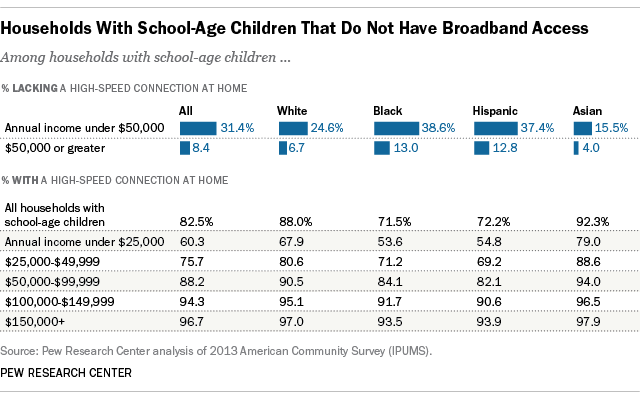
Today, nearly all school districts in America assign online homework, and most high school students need to be online to study. As part of the Obama administration’s ConnectED program, school districts across America have been working to connect 99 percent of schools with next-generation broadband and high-speed wireless access by 2018. Moving forward, a key challenge in the 2016 U.S. Department of Education National Education Technology Plan is how educators should effectively use connected technology in teaching. In school, changes in technology and Internet access have the potential to further empower students’ active learning.
However, not all students have Internet access at home, creating a “homework gap” where connected learning stops at the school exit.

Although over 80% (almost 24 million) families with school-age children enjoy Internet access at home, a disproportionate number of lower-income families make up the five million households with school-age children that lack home internet connectivity. Furthermore, lower-income families with school-age children that do have Internet connectivity are under-connected. In 2015, a third of families below the federal poverty level only accessed the web from their mobile devices. While robust access to the Internet at school aid learning for these students, losing connectivity their last mile home contributes to an inconsistent educational experience.
With twenty percent of students in America are falling behind in an increasingly competitive global educational area, it is crucial to close the homework gap. The failure to address the growing digital “homework gap” can exacerbate the existing social and economic inequalities keeping nearly 1 in 3 students in lower income families from accessing the educational resources needed to succeed in the 21st classroom, workplace, and beyond.

Internet connectivity would help level the playing field for these students.
Increased household Internet access would require better reach of discounted Internet programs and expanded service to lower-income families. The Federal Communications Commission (FCC) can serve an oversight and participatory role. As broadband connectivity in general is a technical issue, expanding access has enormous policy implications; the FCC should also ensure that basic Internet service overall reaches its existing speed benchmarks. The FCC should also continue to encourage service providers to reach rural areas and tribal lands, as these areas have historically been underserved by technology deployment. ConnectED and the Department of Housing and Urban Development’s ConnectHome programs serve as complementary models for expanding Internet access for children in lower-income families.
Lifeline, an FCC subsidy program, was modernized in March 2016 to support broadband subscriptions, over landline phone service. The Internet Essentials program by Comcast has connected over 750,000 low-income families with children eligible to participate in the National School Lunch Program.
In cities like Austin, projects such as Google Fiber have successfully targeted lower-income households for connectivity through “community connections,” but requires buy-in from the community at large. The FCC can encourage other Internet providers to promote similar programs, and companies like Sprint are working with non-profit agencies and community organizations to connect students through its 1Million Project. The Free Basics program by Facebook could be another potential consideration for domestic deployment if regulatory issues are adequately addressed.
Funding broadband expansion programs may grow expensive, but with private industry support, public-private partnerships may be cost-effective. Additionally, scaling the ConnectED and ConnectHome pilot programs may prove difficult nationwide due to local regulations, if they are continued over the next several years. Finally, it is unclear where telecommunications reform falls on President-elect Trump’s agenda. Navigating the next four years will be a new challenge, but addressing the issue of opportunity for all students will be worth the effort.





